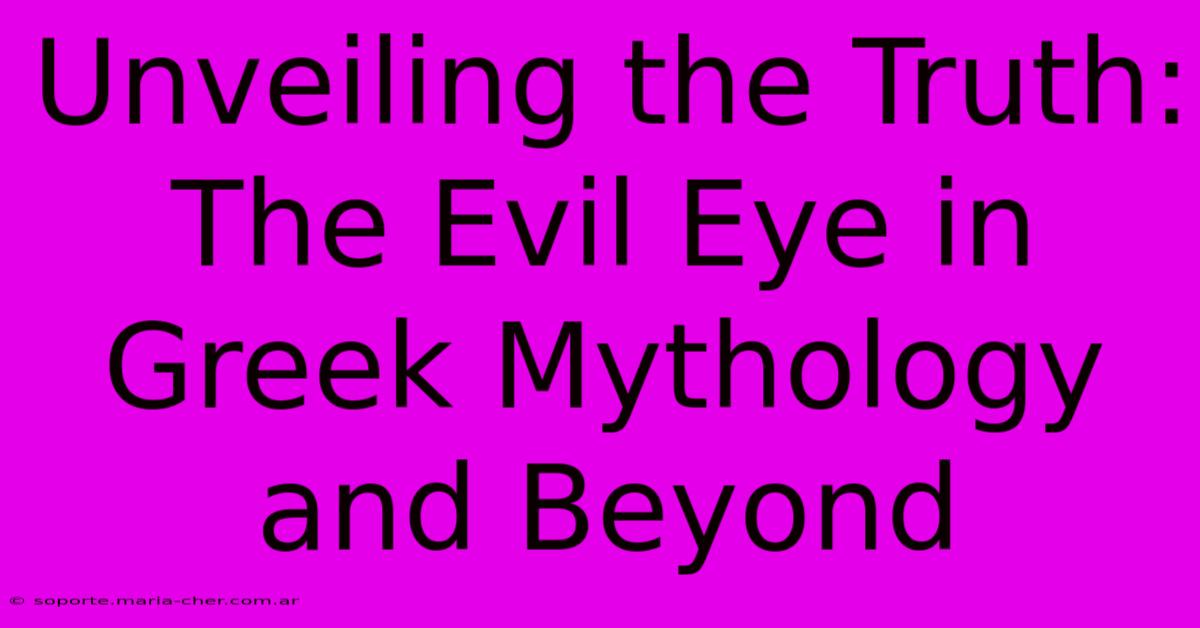Unveiling The Truth: The Evil Eye In Greek Mythology And Beyond

Table of Contents
Unveiling the Truth: The Evil Eye in Greek Mythology and Beyond
The Evil Eye, or matiasma (μάτιασμα) in Greek, isn't just a superstition; it's a deeply ingrained cultural belief with roots stretching back millennia. From ancient Greece to modern-day practices across numerous cultures, the fear of the Evil Eye's malevolent power remains surprisingly potent. This article delves into the history, mythology, and enduring impact of this fascinating and often frightening phenomenon.
The Evil Eye in Ancient Greece: Origins and Myths
The concept of the Evil Eye in ancient Greece wasn't a singular, codified belief but rather a pervasive anxiety woven into the fabric of daily life. While not explicitly attributed to a single god or goddess, the power was widely understood and feared. The belief centered on the potential for someone, often unwittingly, to inflict harm or misfortune through their envious gaze. This wasn't necessarily malicious intent; a simple glance of intense admiration or covetousness could unleash the curse.
Manifestations of the Evil Eye's Power
The effects of the Evil Eye were believed to be varied and devastating, depending on the strength of the envious gaze and the vulnerability of the victim. These could range from minor ailments and misfortune to severe illness, injury, or even death. Children were considered particularly susceptible due to their perceived innocence and vulnerability.
- Sudden illness: Unexplained fevers, fits of crying, and general malaise were often attributed to matiasma.
- Loss of livestock or crops: A farmer might see their animals suddenly fall ill or their harvest fail, blaming the envious gaze of a neighbor.
- Financial ruin: Business setbacks and unexpected losses were often linked to the malevolent power of the Evil Eye.
Combating the Evil Eye: Protective Amulets and Practices
Given the widespread fear, various protective measures developed over time. These protective charms and rituals were designed to ward off the Evil Eye's harmful influence.
The Power of the "Apotropaic"
Apotropaic magic, designed to ward off evil, was central to combating the Evil Eye. Common methods included:
- Amulets and Talismans: The iconic blue eye amulet, known as a "nazar," became particularly prominent. These were believed to deflect the envious gaze, absorbing the negative energy. Other amulets included representations of protective deities or symbols.
- Verbal Charms: Specific phrases or incantations were spoken to counteract the Evil Eye's influence. These often invoked protective deities or forces.
- Rituals and Offerings: Specific rituals and offerings to gods and goddesses were performed to seek their protection.
Identifying the "Evil Eye": Symptoms and Diagnosis
Recognizing the signs of the Evil Eye was crucial. Symptoms could manifest physically or through unexplained misfortune. In some cases, a specific individual might be suspected. Traditional healers and spiritual advisors played an essential role in diagnosis and treatment.
The Evil Eye: A Global Phenomenon
While rooted in Greek mythology, the belief in the Evil Eye transcends geographical boundaries. Similar beliefs and practices exist in numerous cultures around the world, demonstrating the universality of this ancient fear. From the Middle East to Latin America, variations on the Evil Eye exist, highlighting its enduring presence in human societies.
Modern Interpretations and Psychology
While the supernatural explanations are central to the tradition, some researchers explore psychological factors contributing to the belief. Envy, jealousy, and the anxiety associated with unexplained misfortune might contribute to the persistence of the Evil Eye's legacy.
The Enduring Legacy of Matiasma
The belief in the Evil Eye remains surprisingly prevalent even today, particularly in many Mediterranean and Middle Eastern cultures. While scientific explanations may challenge the supernatural elements, the cultural significance of matiasma continues to shape daily life, customs, and beliefs. Its enduring legacy underscores the power of ancient traditions and the enduring human need to understand and control the unpredictable forces of life.

Thank you for visiting our website wich cover about Unveiling The Truth: The Evil Eye In Greek Mythology And Beyond. We hope the information provided has been useful to you. Feel free to contact us if you have any questions or need further assistance. See you next time and dont miss to bookmark.
Featured Posts
-
Hack The Ultimate Weapon For Prompt Customer Response
Feb 06, 2025
-
Embrace The Rustic Allure Of Burnt Orange Elevate Your Decor With A Hint Of Earthy Elegance
Feb 06, 2025
-
Swish And Giggles 50 Hilarious Fantasy Basketball Team Names That Ll Make Your League Laugh
Feb 06, 2025
-
Tropical Twist Unlocking The Exotic Charms Of Yellow Spray Roses
Feb 06, 2025
-
Newcastle Triumphs 4 0 On Aggregate
Feb 06, 2025
